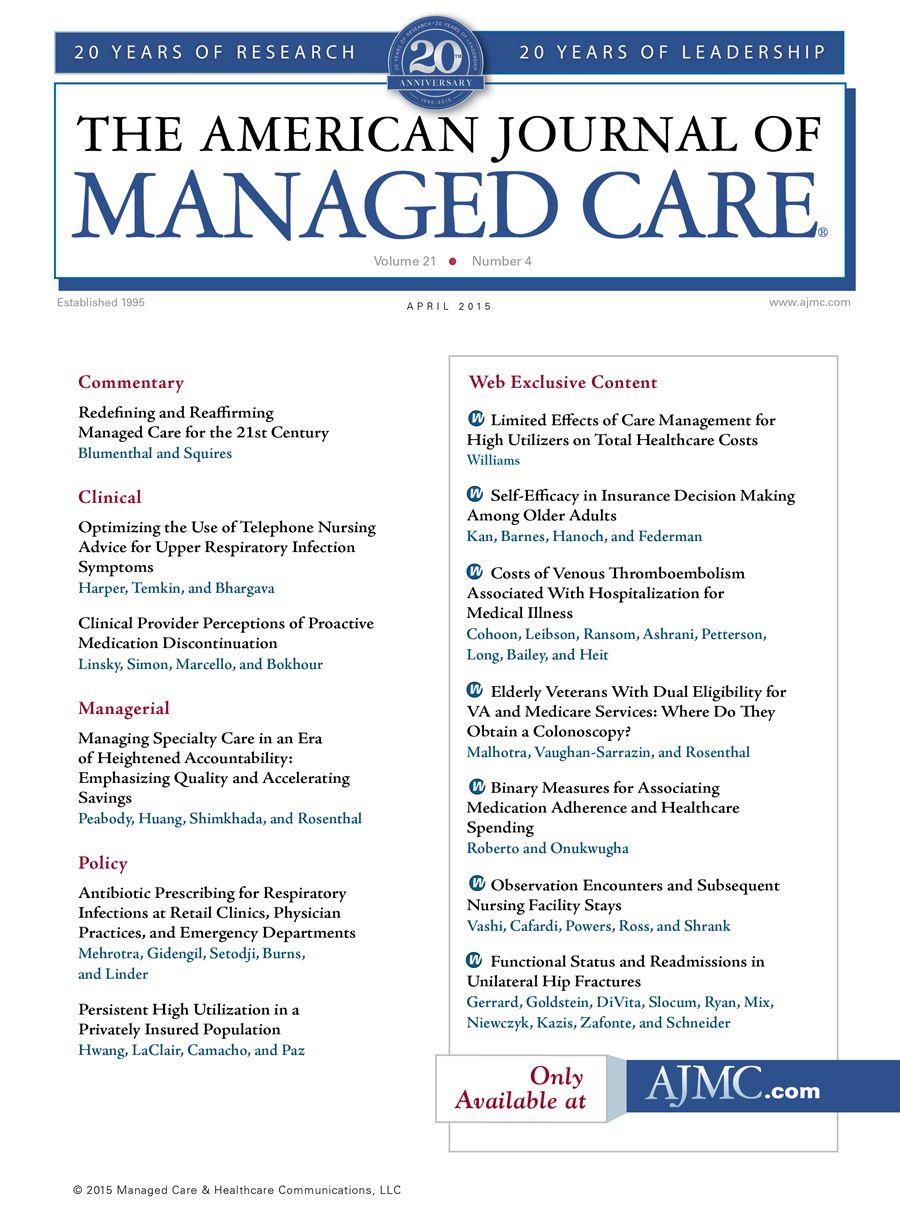- Center on Health Equity & Access
- Clinical
- Health Care Cost
- Health Care Delivery
- Insurance
- Policy
- Technology
- Value-Based Care
Redefining and Reaffirming Managed Care for the 21st Century
Innovations are powering the evolution of patient-centered care, and health plans are at the center of this innovation story.
The term “managed care” is dangerously close to meaninglessness, and unlike pornography, as famously stated by United States Supreme Court Justice Potter Stewart, we may not even recognize it when we see it. Group Health Cooperative of Puget Sound, Kaiser Permanente, and Geisinger are managed care organizations (MCOs). But so are Medicaid plans that—after taking a cut—pay the clinicians’ fee for service and call it a day. The MCO alphabet soup has come to include HMOs, PPOs, ACOs (MSSP and Pioneer), MA plans, PCMHs, IDNs, IPAs, and who knows what else. The very concept of managed care, with its somewhat paternalistic implication of organizational and/or clinician direction of care, seems to run crosswise of the emergent trend toward patient engagement in and control over the care experience.1
Still, few consumers want care that is completely unmanaged, and clinicians talk every day about the management of their patients’ problems: the management of chronic illness and acute illness, of diabetes and appendicitis, of schizophrenia and depression. The optimal management of care, and the creation of policy and organizational environments that facilitate it, continue to have deep intuitive resonance. It is time to retool the term managed care for the 21st century.
That process should start with a review of the major domains of service that can and should be managed for the benefit of patients, and by addressing the seeming—but not inherent—contradiction between care management and patient engagement and empowerment. These are the tasks we set out to do here.
Benefits Management
Certain types of MCOs serve as both insurer and provider. These organizations have to manage benefits as part of the managed care experience.
Clinical benefits management in this setting covers services whose value is supported by evidence. Based on insights from comparative effectiveness research, benefits management should exclude or discourage the use of services shown to be unsafe, ineffective, inferior to alternatives, or not cost-effective. Financial or nonfinancial incentives can also be developed to help shape patients’ choices, such as cost-sharing schemes to nudge patients toward highly effective services. The area of behavioral economics offers useful insights into how to manage proven benefits most effectively.
Clinical Management
Proper care management involves the application by clinicians and MCOs of a series of clinical strategies and techniques that are likely to result in better-coordinated, cost-effective, patient-responsive, and high-value services. These approaches include:
• proactive management of conditions between visits;
• good information systems with clinical decision support;
• predictive analytics to identify patients most likely to benefit from intervention;
• use of patient registries;
• care teams that include a variety of clinicians;
• strategies to address the nonmedical determinants of health;
• management of patient experience, informed by patient surveys; and
• an emphasis on shared decision making.
Clinical management techniques can be employed in any setting, but are likely to be easier and more successful when supported by an infrastructure that enables collaboration and information-sharing across providers, between patients and providers, and even among patients where appropriate. This infrastructure can be provided by external organizations or developed in-house, but will always need to be tailored to the local contexts.
Patient Engagement
Finally, it is important to broaden the concept of care management to include patients as managers of their care experience. For patients with health problems, self-management (or co-management with a clinician) is a powerful tool. For this reason, patient engagement is the third domain of managed care.
As with clinical management, patient engagement can occur anywhere, but is most likely to succeed when supported by an underlying infrastructure. One area where this infrastructure is rapidly developing is the growing market of consumer-directed health information technology products. Patient portals, for example, allow patients to remotely connect with their clinicians or access their medical records, and OpenNotes developers are experimenting with enabling patients to add to provider records. Important new opportunities are arising for patients to voluntarily augment their health information through apps, smart watches, biosensors, and other innovations coming down the tech pipeline.
Another strategy for empowering patients is to improve transparency—in other words, give them reliable information on quality and cost. Such information is currently mostly unavailable or shielded behind proprietary contracts. Having it available when patients need it and in a form that they can understand is necessary for them to make treatment choices and fully participate in shared decision making.
These and other methods for elevating patients’ agency and decision making are increasingly demanded by patients, and they should be part of the managed care concept for the 21st century.
Author Affiliation: The Commonwealth Fund (DB, DS), New York, NY.
Source of Funding: None.
Author Disclosures: The views presented here are those of the authors and not necessarily those of The Commonwealth Fund or its directors, officers, or staff.
Author Information: Concept and design (DB, DS); drafting of the manuscript (DB, DS); critical revision of the manuscript for important intellectual content (DB, DS).
Address correspondence to: David Blumenthal, MD, MPP, The Commonwealth Fund, 1 E 75th St, New York, NY 10021. E-mail: db@cmwf.org.REFERENCES
1. Binder L. Value-based purchasing versus consumerism: navigating the riptide. American Journal of Accountable Care. 2015;3(1):11-14.

Managed Care Reflections: A Q&A With Laurie C. Zephyrin, MD, MPH, MBA
November 12th 2025To mark the 30th anniversary of The American Journal of Managed Care, each issue in 2025 includes a special feature: reflections from a thought leader on what has changed—and what has not—over the past 3 decades and what’s next for managed care. The November issue features a conversation with Laurie C. Zephyrin, MD, MPH, MBA, senior vice president for achieving equitable outcomes at the Commonwealth Fund. This interview has been edited for length and clarity.
Read More

